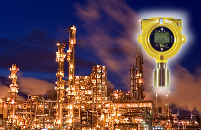Lower Explosive Limit Detectors
Combustible Gas (LEL) Lower Explosive Limit Detectors are used to prevent explosions. When the necessary factors are present such as a minimal quantity of explosive gas, oxygen, enough molecular energy to continue the reaction and a source of ignition, an explosion can occur. The Lower Explosive Limit varies depending on the gas. Therefore, it is important to understand and correct those factors which utilize these detectors to their fullest extent.
Correction Factors
The LEL Detector uses sensors to identify the presence and quantity of the explosive gas. In order to correct and calibrate the detector, three objectives must be met. They must be checked frequently. The scale of calibration must ensure the right sensitivity, and the use of a correct mixture to protect sensor deterioration must be utilized. To determine that a sensor is correctly reading the gas mixture, it should be tested with a known concentration of the gas which is being employed in the business process.
This is a functional test. These tests should be conducted according to manufacturer recommendations and depending on the level of the reading, the detector may or may not need to be adjusted. The (ISEA) International Safety Equipment Association has established a procedure to determine under what conditions the time between checks of the detector may be increased while still maintaining safety.
Correction factors allow the user to calibrate multiple gases or chemicals utilizing either methane or pentane as the calibration gas. The calibration gas must not be past the expiration date. The process of utilizing correction factors can be accomplished in several different ways.
• Use methane to read in methane %LEL corresponding quantities. The result should be multiplied by the CF (correction factor) to determine the percent of LEL gas.
• The detector can be calibrated with methane and can get the correction factor from the detector memory or a computer. The instrument will read the percent of LEL of the intended gas.
• The detector can be calibrated with methane and the corresponding corrected span gas concentration is entered.
Adjusting the Correction Factors
When a sensor is new, the correction factor will be different than a sensor which has been used for a time. It may lose some sensitivity to methane. Because of the loss of sensitivity, the correction factors will decline, and calibration with methane will not give a correct reading on the detector. In these instances, propane or pentane can be used.
Correction Factors with Other Gases
When using other span gases, it is possible to find the correction factor needed by dividing the quantity shown on the methane scale of a Correction Factors Table by the methane value of the span gas. Correction Factors Tables may be found on the web or the information may be included in the detector information. It is critical that LEL Detectors be checked on a regular schedule and corrected by using correction factors to ensure ongoing safe operation of the unit.252

